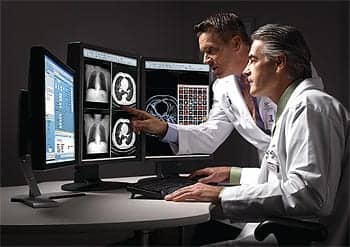 Ueli Laupper Ueli Laupper |
Digital radiography is proving its versatility daily. With an installed base in large and small hospitals, imaging centers, orthopedic clinics, emergency departments, and specialized settings around the world, Swissray has shown that its direct digital Radiography ddR technology enhances productivity and reduces costs while still producing diagnostic images of the highest quality. In addition, Swissray ddR ‘s compatibility with information infrastructure promotes today’s ideal of filmless operation-and helps its users prepare for tomorrow’s mandatory electronic medical record.
The advantages of ddR in the academic radiology setting are described in the article ” Academic Radiology and ddr “. At the University of Kentucky Medical Center, Lexington, the efficiency of ddR is allowing academic radiologists to devote more time to educating residents, and the consistency of the images obtained is helping students and residents notice subtle changes. At the University of Maryland Medical Center, Baltimore, the institution’s academic mission is supported by ddR because radiologists in training are being introduced to state-of-the-art technology.
The emergency department represents what is undoubtedly among the most challenging environments in all of medicine, both for staff and for the equipment that they employ. In ” The Trauma Workhorse ,” emergency and trauma facilities report that Swissray ddR systems, by avoiding the use of fragile (and expensive) flat panels, are durable enough for the demands of high patient volumes. In settings that can damage more delicate equipment, ddR is described as a workhorse that can increase efficiency 30% to 50%. European experience with ddR in trauma treatment is exemplified by Leeuwarden Hospital, Netherlands; facility results and recommendations are summarized in the article about ” A European ED Success Story .”
The use of ddR as a screening tool for contagious pulmonary disease is explored in ” Fighting Pulmonary Disease .” The technology is being employed to screen entrants at US borders for tuberculosis, as well as to conduct ongoing, mandatory tuberculosis screening of South African miners in an industrial-health setting. The appearance of severe acute respiratory syndrome (SARS) has also prompted Chinese facilities to install ddR units for use in SARS screening. In all of these settings, the screening process has been streamlined; because more people can be screened, infection control is likely to improve.
Imaging in pediatric cases presents its own set of challenges, but ddR is designed to help radiology providers cope with the difficulties encountered in imaging children. In ” Improving Pediatric Imaging Service ,” ddR is shown to benefit children by keeping radiation doses low and by allowing parents to calm children who are injured or ill.
In the article ” Bringing Orthopedics Into Focus ,” orthopedic radiology practices describe the ability to manipulate ddR images at the workstation, enhancing fine detail and overall diagnostic utility. Knee and hip replacements and scoliosis treatment, in particular, demand high-quality images that ddR supplies. In addition, ddR units are being paid for by labor savings alone, although the costs of film and processing are also eliminated.
Swissray is, as always, ready to help imaging facilities of all types and sizes explore what ddR technology can do to help them provide high-quality imaging services with increased patient throughput, better general efficiency, reduced costs, and greater staff satisfaction. Toward that end, Swissray is pleased to sponsor the publication of this supplement.
Ueli Laupper is Senior Vice President of Worldwide Sales and Marketing, Swissray International.



